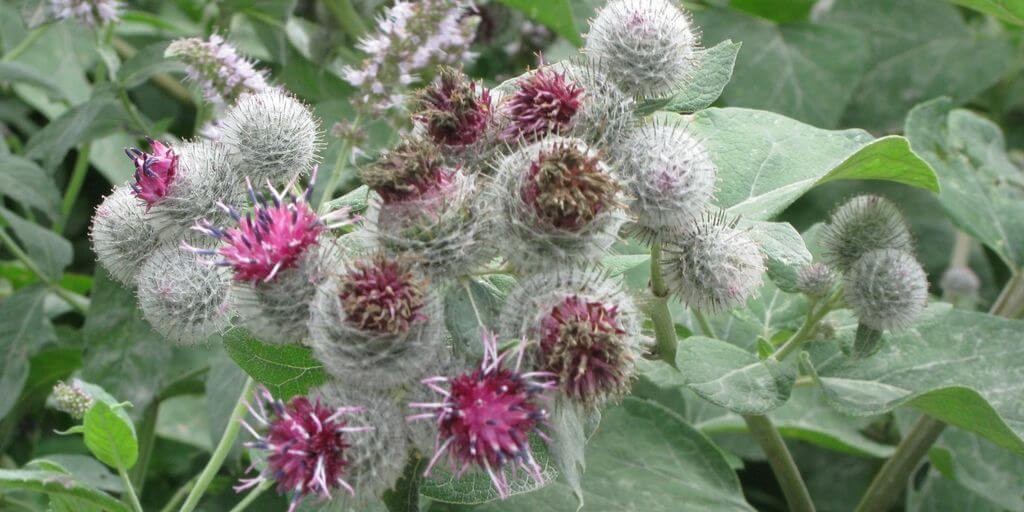Burdock is a plant traditionally known for its many uses. In this article, we include some information on some of its recorded uses.
General compounds and effects of burdock reported in the literature
Classification | Compound | Molecular Formula | Parts of the plant | Effect | Reference |
|---|---|---|---|---|---|
Lignans | Arctigenin | C12H24O7 | Leaves, fruits, seeds, roots | Suppressor of heat shock; Antitumor; Anti-influenza virus | (Ishihara et al., 2006) (Awale et al., 2006) (Gao et al., 2002) |
Lignans | Arctiin | C27H34O11 | Leaves, fruits, roots | Anti-tumor-promoting activity; chemopreventive activity; antiproliferative activity against B cell hybridoma cell, MH60 | (Takasaki et al., 2000) (Hirose et al., 2000) (Matsumoto et al., 2006) |
Lignans | Trachelogenin | C21H24O7 | Fruits | Ca2+ antagonist activity ; Anti-HIV properties | (Ichikawa et al., 1986) (Xia et al., 2001) |
Lignans | Lappaol F | C40H42O12 | Fruits, seeds | Inhibiting NO production | (Park et al., 2007) |
Lignans | Diarctigenin | C42H46O12 | Fruits, roots, seeds | Inhibiting NO production; | (Park et al., 2007) |
Terpenoids | Beta-eudesmol | C15H26O | Fruits | Antibacterial, .antiangiogenic | (Yayli et al., 2005 (Tsuneki et al., 2005)) |
Polyphenols | Caffeic acid | C9H8O4 | Stems, leaves, the skin of roots | Antioxidative; free radical scavenging activity | (Pari and Prasath, 2008) (Bhat et al., 2007) |
Polyphenols | Chlorogenic acid | C16H18O9 | Leaves; the skin of roots | Neuroprotective ; Antioxidative ; anti-anaphylaxis and Anti-HIV ; | (Li et al., 2008) (Bouayed et al., 2007) (Chen et al., 2004) |
Polyphenols | Tannin | C76H52O46 | Roots | Anti-tumor; Immuno-modulator; haluronidase inhibition | (Miyamoto et al., 1993) (Bralley et al., 2008) |
Fructose | Inulin | (C6H10O5)n | Roots | Prebiotic effectiveness ; antihypertension; anti-diabetes | (Li et al., 2008) (Rault-Nania et al., 2008) (Silver and Krantz Jr, 193) |
Sterols | Sitosterol-beta-D-glucopyranoside | C35H60O6 | Roots | mammalian DNA polymerase λ; anti-diabetes and obesity | (Mizushina et al., 2006) (Silver and Krantz Jr, 1931) |
Popular uses
- It has a direct influence on the blood, and as such conditions affecting the skin and mucous membranes.
- Its influence upon the mucous membranes of the stomach encourages normal glandular secretion and promotes digestion.
- It influences the mucous membranes of the air passages when irritated from any blood disorder, alleviating irritable coughs.
- It cures psoriasis and chronic cutaneous eruptions.
- It has a marked influence upon chronic glandular enlargements and is beneficial in syphilitic, scrofulous and gouty conditions.
- It relieves irritation of the urinary tract, promoting a free flow of the urine.
Assessment Report on Arctium lappa (Burdock)
 Loading...
Loading...
This article is copyrighted by Ital is Vital, 2025. Want to re-post this article? Visit our guidelines.
DISCLAIMER: THIS WEBSITE DOES NOT PROVIDE MEDICAL ADVICE
The information, including but not limited to, text, graphics, images and other material contained on this website are for informational purposes only. The purpose of this website is to promote broad consumer understanding and knowledge of various health topics. It is not intended to be a substitute for professional medical advice, diagnosis or treatment. Always seek the advice of your physician or other qualified health care provider with any questions you may have regarding a medical condition or treatment and before undertaking a new health care regimen, and never disregard professional medical advice or delay in seeking it because of something you have read on this website.
